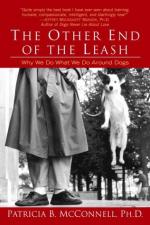
|
| Name: _________________________ | Period: ___________________ |
This test consists of 15 multiple choice questions and 5 short answer questions.
Multiple Choice Questions
1. According to McConnell, how do dogs feel about humans petting them?
(a) They do not always like to be petted.
(b) They sometimes like to be petted when they're hungry.
(c) They always like to be petted.
(d) They only like to be petted after they've eaten.
2. How conscious are dogs of their pheromones?
(a) Not conscious.
(b) Conscious except during sex.
(c) Conscious.
(d) Not conscious except during sex.
3. What form of play does McConnell NOT recommend?
(a) Hide and Seek.
(b) Fighting.
(c) Tricks.
(d) Fetch.
4. What is the best way to sniff, according to McConnell?
(a) Use short inhales.
(b) Use one short inhale.
(c) Use one long inhale.
(d) Use long inhales.
5. What is the human equivalent of a "hip slam" and "shoulder slam"?
(a) "Back block."
(b) "Leg block."
(c) "Arm block."
(d) "Body block."
6. What is the first step a person should do in order to ingratiate her or himself with a dog?
(a) Talk to the dog from ten feet away.
(b) Approach the dog.
(c) Give treats from your hand.
(d) Throw treats from ten feet away.
7. What is the biggest misconception owner's make regarding their influence on a dog's behavior?
(a) That their voice is their biggest influence.
(b) That their body is their biggest influence.
(c) That their size is their biggest influence.
(d) That their speed is their biggest influence.
8. According to McConnell, what do decades of research indicate about what almost all dogs respond to?
(a) That almost all dogs respond to physical stimuli.
(b) That almost all dogs respond to gustation stimuli.
(c) That almost all dogs respond to aural stimuli.
(d) That almost all dogs respond to visual stimuli.
9. What are the corners of a dog's mouth called?
(a) Cissurres.
(b) Closurres.
(c) Ceassures.
(d) Commissures.
10. Whose nostrils can move independently from their face?
(a) Primates.
(b) Cats.
(c) Humans.
(d) Dogs.
11. What ingrained behavior is considered affectionate for humans but rude for dogs and should be avoided?
(a) Talking.
(b) Hugging.
(c) Rubbing.
(d) Kissing.
12. What physical behaviors in a dog are NOT important?
(a) Mouth and eyes.
(b) Breathing rate.
(c) Sitting and standing.
(d) Leaning forward and back.
13. What kind of animal behaviorist is Patricia McConnell?
(a) A theoretical animal behaviorist.
(b) A genetic animal behaviorist.
(c) An applied animal behaviorist.
(d) A biological animal behaviorist.
14. According to McConnell, an owner's body should be trained like what?
(a) An athlete's.
(b) A psychologist's.
(c) A mechanic's.
(d) A dog's.
15. What is habituation?
(a) Habituation is the final step in dog training.
(b) Habituation occurs when a stimulus is so contant as to become meaningless.
(c) Habituation is the process of cohabitating with a dog.
(d) Habituation occurs when a dog has a habit that cannot be broken.
Short Answer Questions
1. Why would an owner use "pup pup pup"?
2. When a person cocks his or her head, what does it tell the dog?
3. How can an owner make themselves the object of a chase?
4. Can dogs sniff out land mines and cancer?
5. Why did a dog growl and snap at visitors who had recently eaten pizza?
|
This section contains 597 words (approx. 2 pages at 300 words per page) |

|




